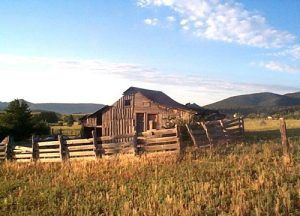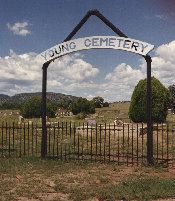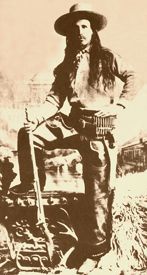
Pleasant Valley, Arizona
Typically, cattlemen and sheep-herders in the Old West didn’t get along, and this was no exception in the Pleasant Valley of Arizona during the 1880s. The Pleasant Valley War, also called the Tonto Range War, first began as early as 1882 between the cattle-herding Grahams and the sheep-herding Tewksburys.
Though the feud would last for almost a decade, it was most heated between 1886 and 1887. The conflict between the two factions began over property lines and water and grazing rights. Adding fuel to the fire was the long-standing cowboy disdain for sheep-herders. Even without legitimate conflicts, there would, no doubt, have been a personal dislike of the Tewksburys on the part of the Grahams. The Grahams also contended that the sheep grazed the open range clean, leaving nothing for the cattle.
Ironically, the Tewksburys were cattlemen but supported the sheep-herders due to a long-standing quarrel with the Grahams. This first dispute was said to have been over cattle stolen from a man named James Stinson. In any event, when the Pleasant Valley conflict erupted, the Tewksbury’s gave protection to a band of sheep owned by the Daggs brothers of Flagstaff.
In addition to the Grahams, numerous other settlers in the area were upset at the appearance of sheep on the open range that had been previously utilized exclusively by cattle. Those who had not taken part in the Tewksbury-Graham quarrel before began to unite in defending their range against the sheep. Almost every man in the valley was eventually drawn into the conflict.
The long-standing argument turned deadly when, in February 1887, a Navajo Indian employed by the Tewksburys was herding sheep in an area called the Mogollon Rim. This vicinity had been accepted as the line across which sheep were not permitted. The Indian was shot and killed by Tom Graham, who also drove out or destroyed the sheep. This event began the bloody battle responsible for 19 known deaths and as many as 30. At one point, known hired killer Tom Horn took part in the “war,” but it has never been established which side employed him.
On August 17, 1887, William Graham was gunned down at his home but lived long enough to identify Ed Tewksbury as the shooter. Later, Apache County Deputy Sheriff James D. Houck would publicly announce the shooting and killing of William Graham. Some believed this was to take the pressure off of Tewksbury. In the end, a jury found Tewksbury guilty in his absence, and Sheriff Mulvenon set out to arrest the man, but he had fled into the hills.
In September 1887, the Graham faction surrounded one of the Tewksbury cabins and shot down John Tewksbury and William Jacobs as they started for horses. Though the two were dead, the Grahams continued firing at the cabin for hours, only stopping when Mrs. Tewksbury finally came out with a shovel to bury the dead men.
A few days later, a man named Andy Blevins, a member of the Graham faction, was overheard in Arizona, bragging that he had killed both Tewksbury men. Holbrook Sheriff, Commodore Perry Owens, got wind of the confession and, having a warrant for Blevin’s arrest for cattle rustling, decided it was a good time to pick up the lawless man.
When Owens went to the Blevins family home on September 4, 1887, the family was in the midst of Sunday dinner, and Andy refused to come out. Within moments, Andy’s half-brother, John, opened the door and took a shot at the sheriff, who quickly drew his six-guns, sending bullets into both John and Andy.
A gunfight inevitably erupted, and Sam Blevins, just 15 years old, ran out the door firing at Owens, who returned the shots. A friend of the Blevin family named Mose Roberts also fired upon the Sheriff. The melee, lasting less than a minute, left Andy and Sam Blevin and Mose Roberts dead. John Blevins was wounded. Despite the many shots fired at him, Owens was uninjured, and as word spread about the gunfight, it made the man a legend. Though the shooting was ruled as self-defense, Owens was fired by the County over the incident.
Later that month, Sheriff Mulvernon of Prescott pursued brothers John and Tom Graham and Charles Blevins to Young, Arizona. Leading a posse sprinkled with Tewksbury sympathizers, they caught up with the trio on September 22.
As the three men approached Perkins Store, Mulveron demanded their surrender, but instead, a shoot-out ensued. When the dust cleared, John Graham and Charles Blevins lay dead. Tom Graham was able to escape.
Over the next few years, several lynchings and unsolved murders of members of both factions took place, often committed by masked men.
In August 1892, the feud ended when the last of the Grahams, Tom Graham, was murdered in Tempe, Arizona. Before he died, Tom said that the shooter was Edwin Tewksbury, which several witnesses confirmed. Ed was arrested for the murder and tried two times. However, the first trial resulted in a hung jury. The second trial ended in a conviction, but the verdict was deferred because of a legal technicality, and in 1895 the case was dismissed.
Edwin Tewksbury was the last of the men involved in the Pleasant Valley War. He died in Globe, Arizona, in April 1904.

Young Cemetery, Arizona
Today, some of the graves of many of the murdered men can still be seen in the Young, Arizona cemetery, and the Perkins Store still stands as a museum.
© Kathy Weiser-Alexander/Legends of America, updated November 2021.
Also See:
Arizona – The Grand Canyon State
Tom Horn – Wyoming Killer for Hire
Forgotten Gunfighters: The Pleasant Valley War, Produced by Michael Blast, 1999. Documentary run time 49 min.

